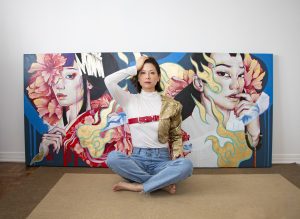
The complicated question of Asian-American identity is explored in an exhibit running through next month at the Morikami Museum and Japanese Gardens in suburban Delray Beach.
Beyond the Wall: Visions of the Asian Experience in America, on view through Sept. 25, explores the Asian-American experience in the United States through a non-traditional mural exhibit.
With the COVID-19 pandemic still a concern last year, the five artists worked at home and shipped their murals — created on canvas, wood panels and bamboo mats specifically for this exhibit —to the museum; thus, the name Beyond the Wall.
“This is a unique exhibit,” says Wendy Lo, education curator for the Morikami.”The exhibition explores the experience of Asian-American artists and provides a platform for them to express their voices and their personal experiences as Asian-Americans living in the U.S.”
“The exhibit highlights the Asian-American experience and growing up with both identities,” says Lo, herself a first-generation Chinese-American from Miami. “While this exhibit explores Asian-American identity, it’s a struggle many people can relate to.”
Beyond the Wall features the work of contemporary artists of Japanese, Chinese and Vietnamese descent who explore their heritage and identities through the large-scale medium of the mural. Noting that the exhibit opened in May during Asian-American Pacific Islander Month, Lo says Asian-Americans in this country are a minority and have faced historical racism as well as more recent hate crimes.

“‘Beyond the Wall’ is a showcase to say we are here and part of a larger, diverse community,”she says. “It’s important for people to hear their voices, open a dialogue. to foster understanding and communication with Asian-Americans and for Asians in the community to feel represented and seen.
“During a symposium held May 6 at the opening of the exhibit, the artists talked about their work in a panel discussion led Mitzi Carter, a professor of anthropology at Florida International University.
Boy Kong, based in Orlando, is a multimedia artist of Chinese and Vietnamese heritage. He draws inspiration from folk art, graffiti, surrealism and ukiyo-e (Japanese for “pictures of the floating world”), and employs various mediums, including paint, collage, and assemblage to create his murals.
For this exhibit, Kong was inspired to bring the garden into the gallery.And, in honor of the Chinese “Year of the Tiger,” he created Three Tigers, one resting, one sitting and a third depicting energy, “a good reminder to rest, or sit and pay attention to your energy,” Kong said. He likens the images to flash cards — each one conveying a message.

Similarly, Casey Kawaguchi, a Japanese-American artist who grew up in mostly white and Mormon Utah, draws on his heritage for inspiration.For this exhibit he created Unmei (Create Your Own Fate). Now based in Denver, Kawaguchi’s artistic practice revolves around a recurring feminine character, juxtaposed on each side by a sword and a brush, representing balance, or the opposite forces of creation and destruction.
“The duality of the sword and the brush represent my own experience making art and the battle I experience internally,” Kawaguchi says. In a short documentary film by David Kaufman titled Mastery, Kawaguchi talks about his artistic process and of getting “fear and doubt out of the way to be in the moment.”
He comes to the realization that his work is a collaboration with life and following his heart.

Juuri, one of three women in the show, is a Tokyo-born Japanese-American artist working in Oklahoma City. Her colorful figure-driven work is inspired by traditional Japanese art, such as bijin-ga (images of beautiful women) and yakusha-e (images of kabuki actors), interpreted through the stylistic lens of modern fashion photography. Other influences include Japanese history, folklore and kabuki theater, with its themes of love, betrayal and seduction.
For this exhibit she has offered Shime, inspired by the kabuki play Shibaraku, one of the most iconic and well-known kabuki plays.
“These stories could be on Netflix,” Juuri says. “They’re still relevant and contemporary. It’s hard to tell the good guys from the bad guys.” she says. “It’s quintessentially Japanese to have many questions and no one answer.”

Paper-cut artist Hiromi Mizugai Moneyhun moved to Jacksonville from Kyoto, Japan, in 2004. She began drawing at a young age and developed her own artistic voice, which combines Japanese kirigami (cut paper), with a hyper-modernity that is synonymous with Japan’s contemporary urban aesthetic movements.
Her mural, Immersion, depicts an un-clothed Japanese woman entering a public bathhouse (sento) and confronted with the dilemma of where to sit.
Also based in Jacksonville is mixed-media artist and photographer, Elena Øhlander.

She created Chō Chō to Hana to Kumo (The Butterfly, The Flower and The Spider) with acrylic, spray paint and mixed media on canvas. She speaks about identity, gender, individuality, pop culture and breaking down societal constructs such as the term “mixed-race.”
As a large-mural artist she talks about the dichotomy of “taking up space,” something she says Japanese women are not known to do.
“My work is a discovery process,” she says.”Public art is a way to connect with people about culture, history, identity and who I am. It opens conversations about the work and about myself as an artist.”
When other Asians and Asian-Americans view her work, they say, “We feel included,” she says. “My goal is to inspire the viewer to break down stereotypes.”

Beyond the Wall runs through Sept. 25 at the Morikami Museum and Japanese Gardens, 4000 Morikami Park Road, Delray Beach. Call 561-495-0233 or visit morikami.org. Artist Hiromi Moneyhun will host a paper-cutting workshop Sept. 10. The nextSunset Stroll is on Sept. 22.